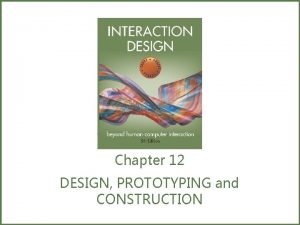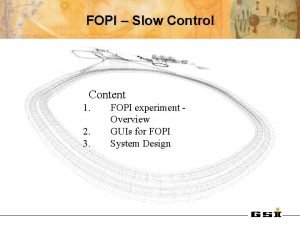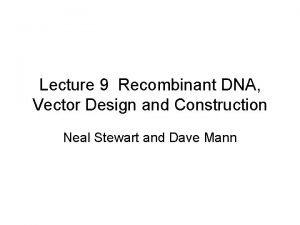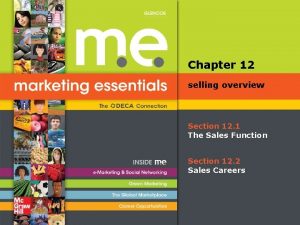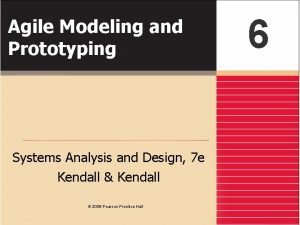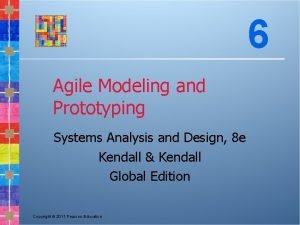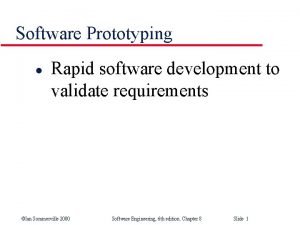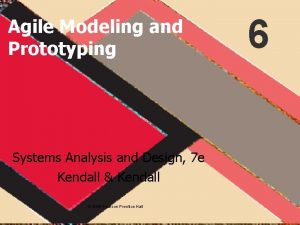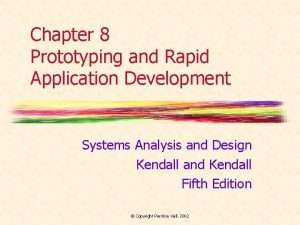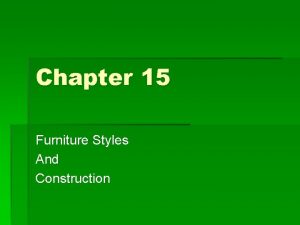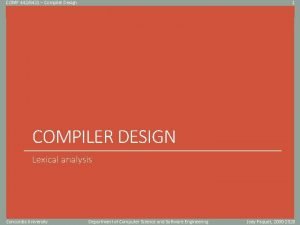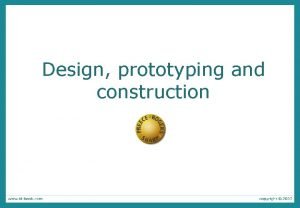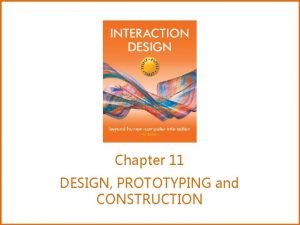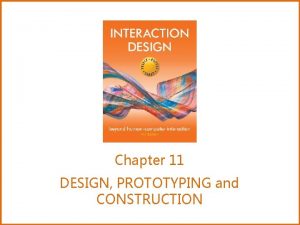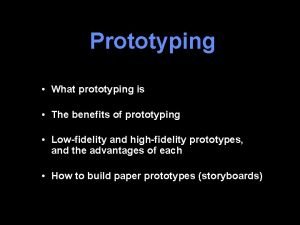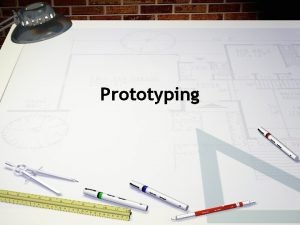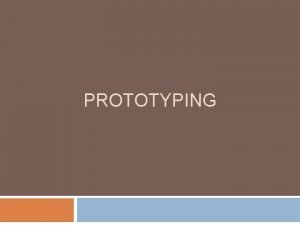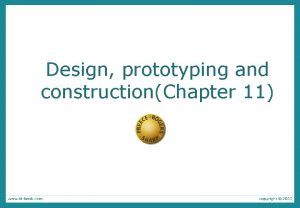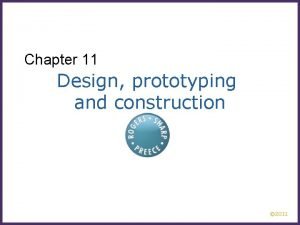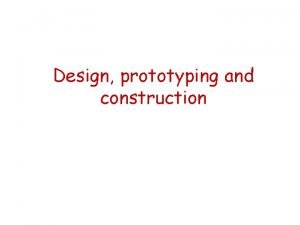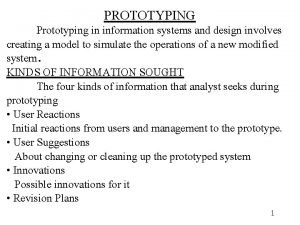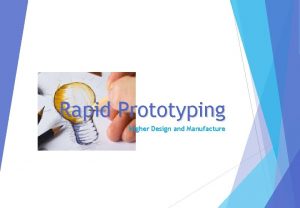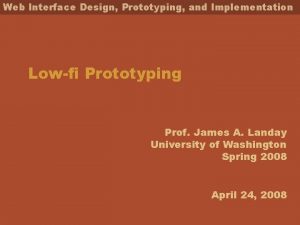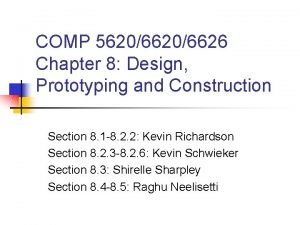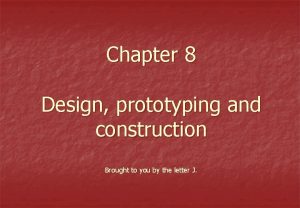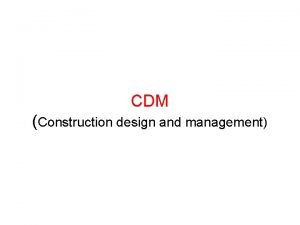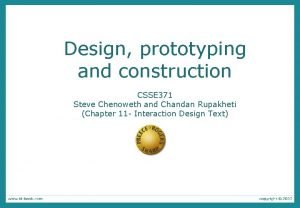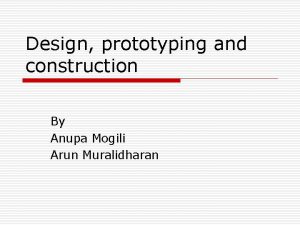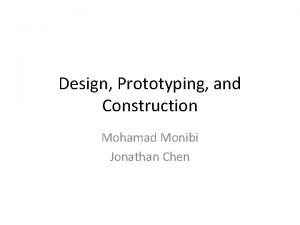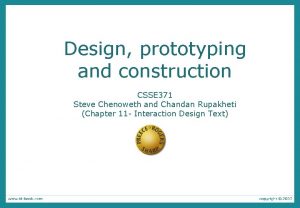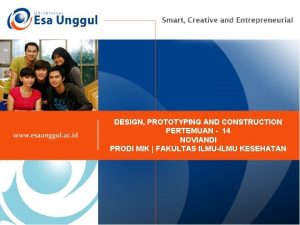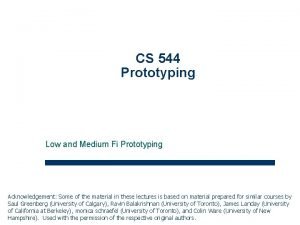Chapter 12 DESIGN PROTOTYPING and CONSTRUCTION Overview Prototyping



































- Slides: 35

Chapter 12 DESIGN, PROTOTYPING and CONSTRUCTION

Overview • Prototyping • Conceptual design • Concrete design • Using scenarios • Generating prototypes • Construction www. id-book. com 2

Prototyping • What is a prototype? • Why prototype? • Different kinds of prototyping § Low fidelity § High fidelity • Compromises in prototyping § Vertical § Horizontal • Final product needs to be engineered www. id-book. com 3

What is a prototype? • One manifestation of a design that allows stakeholders to interact with it • In other design fields, a prototype is a small-scale model: § A miniature car § A miniature building or town Source: Palm. Pilot wooden model © Mark Richards www. id-book. com 4

3 D Printing Examples of 3 D printing: (a) model jet engine, (b) Spider Dress 2. 0 by Anouk Wipprecht, and (c) teddy bear “printed” form a wireframe design Sources: (a) Build Your Own Jet Engine. Licensed under CC-BY-3. 0, (b) arch 20, and (c) used courtesy of Scott Hudson www. id-book. com 5

What is a prototype in interaction design? In interaction design, a prototype can be (among other things): • A series of screen sketches • A storyboard, for example, a cartoon-like series of scenes • A Power. Point slide show • A video simulating the use of a system • A lump of wood (for instance, the Palm. Pilot) • A cardboard mock-up • A piece of software with limited functionality written in the target language or in another language www. id-book. com 6

Why prototype? • Evaluation and feedback are central to interaction design • Stakeholders can see, hold, and interact with a prototype more easily than a document or a drawing • Team members can communicate effectively • Ideas can be tested out • Prototyping encourages reflection: an important aspect of design • Prototypes answer questions and support designers in choosing between alternatives www. id-book. com 7

Low-fidelity Prototyping • Uses a medium which is unlike the final medium, for example, paper or cardboard • Is quick, cheap, and easily changed • Examples: § Sketches of screens, task sequences, and so on § ‘Post-it’ notes § Storyboards § ‘Wizard-of-Oz’ www. id-book. com 8

Storyboards • It is a series of sketches showing how a user might progress through a task using the product • Often used with scenarios, bringing in more detail and a chance to role play www. id-book. com 9

Example storyboard www. id-book. com 10

Sketching • Low-fidelity prototyping often relies on sketching • Don’t be inhibited about drawing ability — Practice simple symbols www. id-book. com 14

Prototyping with index cards • Index cards (3 x 5 inches) • Each card represents one element of interaction • In evaluation, can step through the cards www. id-book. com 15

‘Wizard-of-Oz’ prototyping • The user thinks they are interacting with a computer, but a human is responding to output rather than the system • Usually done early in design to understand users’ expectations • What is ‘wrong’ with this approach? User >Blurb blurb >Do this >Why? www. id-book. com 13

High-fidelity prototyping • Uses materials that you would expect to be in the final product • Prototype looks more like the final system than a lowfidelity version • High-fidelity prototypes can be developed by integrating existing hardware and software components • Danger that users think they have a complete system…see compromises www. id-book. com 14

Compromises in prototyping • Prototyping involve compromises • For software-based prototyping, maybe there is a slow response? sketchy icons? limited functionality? • “In the wild” prototypes operational but not necessarily robust • Two common types of compromise: Horizontal: Provides a wide range of functions, but with little detail Vertical: Provides a lot of detail for only a few functions • Compromises in prototypes must not be ignored. Product needs engineering www. id-book. com 15

Conceptual design • A conceptual model is an outline of what people can do with a product and what concepts are needed to understand interact with it • Understand problem space and current requirements; empathize with users • Creativity and brainstorming techniques • Mood board may capture desired feel • Consider alternatives: scenarios and prototyping helps www. id-book. com 16

Building scenarios www. id-book. com 17

Empathizing with users The Third Age Suit Source: Ford Motor Company www. id-book. com 18

Choosing an interface metaphor • Interface metaphors combine familiar knowledge with new knowledge in a way that will help the user understand the product. • Three steps: understand functionality, identify potential problem areas, and generate metaphors • Evaluate metaphors: § How much structure does it provide? § How much is relevant to the problem? § Is it easy to represent? § Will the audience understand it? § How extensible is it? www. id-book. com 19

Considering interaction and interface types • Which interaction type? § How the user invokes actions § Instructing, conversing, manipulating, exploring, or responding • Do different interface types provide insight? § Shareable, tangible, augmented reality, and so forth www. id-book. com 20

Expanding the initial conceptual model • What functions will the product perform? § What will the product do and what will the human do? • How are the functions related to each other? § Sequential or parallel? § Categorizations, for example, all actions related to privacy on a smartphone • What information is needed? § What data is needed to perform the task? § How is this data to be transformed by the system? www. id-book. com 21

Concrete design • Difference between conceptual and concrete is emphasis • Many aspects to concrete design § Color, icons, buttons, interaction devices, and so on • User characteristics and context § Inclusiveness, input, and output modes • Accessibility § Web Content Accessibility Guidelines • Cross-cultural design § Language, colors, icons, and information architecture www. id-book. com 22

Generating prototypes • Generate a storyboard from a scenario § Break down scenario into steps § Create a scene for each step • Sketching out a storyboard prompts designers to think about design issues • Generate a card-based prototype from a storyboard or from a use case § Consider each step in use case – what interaction element is needed § Draw a card that captures it www. id-book. com 23

Generating storyboard www. id-book. com 24

Generating card-based prototype www. id-book. com 25

Explore the user’s experience • Use personas, card-based prototypes, or stickies to model the user experience • Visual representation called: § Design map § Customer or user journey map § Experience map • Two common representations § Wheel § Timeline www. id-book. com 27

An experience map drawn as a wheel Source: LEGO www. id-book. com 28

An experience map drawn as a timeline Source: Adlin and Pruitt (2010), p 134. Used courtesy of Morgan Kaufmann. www. id-book. com 29

Construction: Physical computing • Build and code prototypes using electronics • Toolkits available include § Arduino § Lily. Pad (for fabrics) § Senseboard § BBC micro: bit § Ma. Key • Designed for use by wide range of people www. id-book. com 30

Physical computing kits The Arduino board Source: Used courtesy of Dr. Nicolai Marquardt www. id-book. com 31

Physical computing kits The Makey toolkit www. id-book. com Source: Makey 32

Physical computing kits The BBC micro: bit Source: micro: bit. Used courtesy of Micro: bit Foundation www. id-book. com 33

Construction: SDKs • Software Development Kits § Programming tools and components to develop for a specific platform, for example, i. OS • Includes: IDE, documentation, drivers, sample code, and application programming interfaces (APIs) • Makes development much easier • Examples: § Amazon’s Alexa Skills Kit for voice-based services § Apple’s ARKit for augmented reality § Microsoft’s Kinect SDK for motion tracking www. id-book. com 34

Summary • Prototyping may be low fidelity (such as paper-based) or high fidelity (such as software-based) • Existing software and hardware helps create prototypes • Two aspects to design: conceptual and concrete • Conceptual design develops an outline of what users can do and what concepts are needed to understand the product. • Concrete design specifies design details, for www. id-book. com 34

Summary (continued) • Three approaches to develop an initial conceptual model: interface metaphors, interaction styles, and interface styles. • Expand an initial conceptual model by considering whether product or user performs each function, how those functions are related, and what information is required to support them • Generate prototypes from scenarios and use cases • Physical computing kits and software development kits facilitate the transition from www. id-book. com 35
 Card-based paper prototypes, sketches and storyboards are
Card-based paper prototypes, sketches and storyboards are Chapter 17 overview elements and their properties
Chapter 17 overview elements and their properties System analysis
System analysis System design overview
System design overview Shrimp farming powerpoint presentation
Shrimp farming powerpoint presentation Network design and construction
Network design and construction Ogs design and construction
Ogs design and construction Andrew poeckes
Andrew poeckes Windmill water pump design and construction
Windmill water pump design and construction Dnaecule
Dnaecule Emt chapter 24 trauma overview
Emt chapter 24 trauma overview Chapter 14 medical overview
Chapter 14 medical overview Chapter 9 lesson 2 photosynthesis an overview
Chapter 9 lesson 2 photosynthesis an overview Chapter 12 selling overview
Chapter 12 selling overview Financial intermediaries
Financial intermediaries Chapter 1 overview of verb tenses
Chapter 1 overview of verb tenses Overview of personal finance chapter 1
Overview of personal finance chapter 1 Overview of the dentitions chapter 11
Overview of the dentitions chapter 11 Overview of personal finance chapter 1
Overview of personal finance chapter 1 Chapter 32 an overview of animal diversity
Chapter 32 an overview of animal diversity Chapter 1 an overview of financial management
Chapter 1 an overview of financial management Chapter 1 overview of financial statement analysis
Chapter 1 overview of financial statement analysis Patched-up prototype
Patched-up prototype Agile modeling and prototyping
Agile modeling and prototyping Rapid throwaway prototype
Rapid throwaway prototype What is the primary goal in agile modeling
What is the primary goal in agile modeling Rapid application development prototyping
Rapid application development prototyping Excessive use of ornamentation and massive proportions
Excessive use of ornamentation and massive proportions Thompson construction in compiler design
Thompson construction in compiler design Design of output
Design of output Virusmax
Virusmax Data quality and data cleaning an overview
Data quality and data cleaning an overview The two rows of elements that seem to be disconnected
The two rows of elements that seem to be disconnected An overview of data warehousing and olap technology
An overview of data warehousing and olap technology What is bioinformatics an introduction and overview
What is bioinformatics an introduction and overview An overview of data warehousing and olap technology
An overview of data warehousing and olap technology
